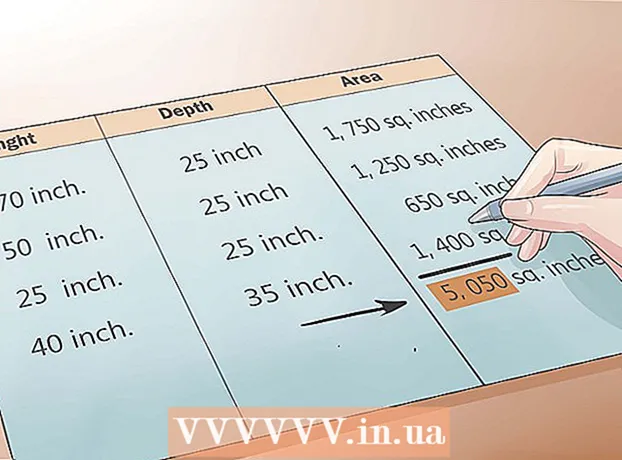Author:
Janice Evans
Date Of Creation:
27 July 2021
Update Date:
1 July 2024

Content
At first glance, adding fractions with different denominators is quite difficult, but if you bring them to a common denominator, everything becomes much easier. If you're working with irregular fractions that have more numerators than denominators, make the denominators the same, and then add the numerators. If you need to add mixed numbers, convert them to improper fractions, bring them to a common denominator, and then add the numerators.
Steps
Method 1 of 2: How to Add Irregular Fractions
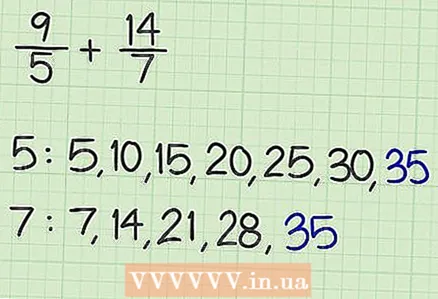 1 Find the least common multiple (LCM) denominators. To bring fractions to a common denominator, you need to find the smallest multiple of both denominators.
1 Find the least common multiple (LCM) denominators. To bring fractions to a common denominator, you need to find the smallest multiple of both denominators. - For example, add the fractions 9/5 + 14/7. The multiples of the denominator 5 are 5, 10, 15, 20, 25, 30, 35, and the multiples of the denominator 7 are 7, 14, 21, 28, 35. So 35 is the least common multiple.
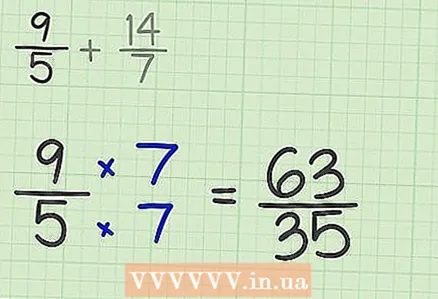 2 Multiply the numerator and denominator of the first fraction by the appropriate number to bring the fractions to a common denominator. Remember that not only the denominator, but also the numerator must be multiplied by this number.
2 Multiply the numerator and denominator of the first fraction by the appropriate number to bring the fractions to a common denominator. Remember that not only the denominator, but also the numerator must be multiplied by this number. - In our example, multiply 9/5 by 7 to get the denominator 35. Also multiply the numerator by 7; thus, you get the fraction 63/35.
 3 Multiply the numerator and denominator of the second fraction by the appropriate number to bring the fractions to a common denominator. Remember that not only the denominator, but also the numerator must be multiplied by this number.
3 Multiply the numerator and denominator of the second fraction by the appropriate number to bring the fractions to a common denominator. Remember that not only the denominator, but also the numerator must be multiplied by this number. - In our example, multiply 14/7 by 5 to get 70/35. Thus, the original problem 9/5 + 14/7 will be rewritten as 63/35 + 70/35.
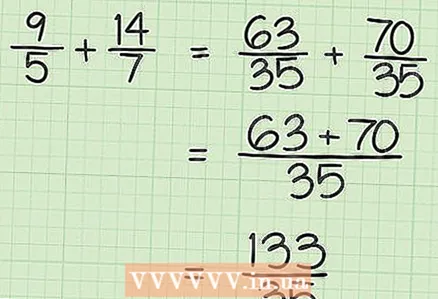 4 Add the numerators and leave the denominators unchanged. When you bring both fractions to a common denominator, add up the numerators.Write the result over the denominator.
4 Add the numerators and leave the denominators unchanged. When you bring both fractions to a common denominator, add up the numerators.Write the result over the denominator. - In our example: 63 + 70 = 133. Write this result over the denominator to get the fraction 133/35.
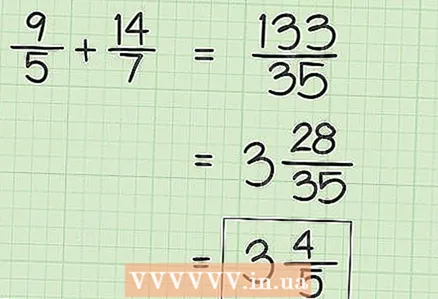 5 Simplify or reduce the resulting fraction (if necessary). If you get an incorrect fraction, turn it into a mixed number. To do this, divide the numerator by the denominator to get an integer. Write the remainder of the division above the denominator. Now the fraction can be canceled (if it can be canceled).
5 Simplify or reduce the resulting fraction (if necessary). If you get an incorrect fraction, turn it into a mixed number. To do this, divide the numerator by the denominator to get an integer. Write the remainder of the division above the denominator. Now the fraction can be canceled (if it can be canceled). - For example, the fraction 133/35 can be converted to a mixed number of 3 28/35. Now reduce the fraction 28/35 to 4/5. So the final answer is 3 4/5.
Method 2 of 2: How to Add Mixed Numbers
 1 Convert mixed numbers to improper fractions. If you are given mixed numbers (they include whole numbers and fractions), convert them to improper fractions to make addition easier. Remember that the numerators of the improper fractions are larger than the denominators.
1 Convert mixed numbers to improper fractions. If you are given mixed numbers (they include whole numbers and fractions), convert them to improper fractions to make addition easier. Remember that the numerators of the improper fractions are larger than the denominators. - For example, add 6 3/8 + 9 1/24. These mixed numbers will become 51/8 + 217/24.
 2 Find least common multiple (LCM) denominators. If the denominators are different, write down the multiples of each, and then find the lowest common multiple. In our example 51/8 + 217/24, write down the multiples of the denominators 8 and 24; you will find that the LCM is 24.
2 Find least common multiple (LCM) denominators. If the denominators are different, write down the multiples of each, and then find the lowest common multiple. In our example 51/8 + 217/24, write down the multiples of the denominators 8 and 24; you will find that the LCM is 24. - The multiples of 8 are 8, 16, 24, 32, 48, and the multiples of 24 are 24, 48, 72. So, the LCM is 24.
 3 Multiply the first fraction (numerator and denominator) by the appropriate number to bring it to a common denominator. The common denominator must be equal to the LCM.
3 Multiply the first fraction (numerator and denominator) by the appropriate number to bring it to a common denominator. The common denominator must be equal to the LCM. - For example, to bring the fraction 51/8 to the denominator 24, multiply the numerator and denominator by 3. You get the fraction 153/24.
 4 Multiply other fractions (numerator and denominator) by the appropriate number to bring them to a common denominator. If in the problem other fractions have different denominators, also multiply them by some number to bring them to a common denominator. If the denominator of the fraction is already equal to the LCM, leave this fraction unchanged.
4 Multiply other fractions (numerator and denominator) by the appropriate number to bring them to a common denominator. If in the problem other fractions have different denominators, also multiply them by some number to bring them to a common denominator. If the denominator of the fraction is already equal to the LCM, leave this fraction unchanged. - In our example, the second fraction is 217/24, that is, its denominator is already equal to the LCM. Thus, this fraction does not need to be changed.
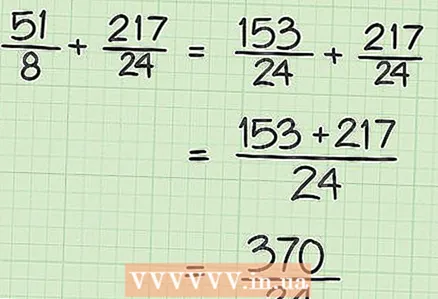 5 Add the numerators and leave the denominator unchanged. Add the numerators when you bring the fractions to a common denominator (or if the denominators of the fractions were the same from the beginning). Write the result of the addition of the numerators over the denominator. Don't add the denominators!
5 Add the numerators and leave the denominator unchanged. Add the numerators when you bring the fractions to a common denominator (or if the denominators of the fractions were the same from the beginning). Write the result of the addition of the numerators over the denominator. Don't add the denominators! - In our example: 153/24 + 217/24 = 370/24.
 6 Simplify the resulting fraction. If the numerator of the fraction is greater than the denominator, divide the numerator by the denominator to get a whole number. Write the remainder of the division above the denominator. Now cancel the fraction (if it's canceling).
6 Simplify the resulting fraction. If the numerator of the fraction is greater than the denominator, divide the numerator by the denominator to get a whole number. Write the remainder of the division above the denominator. Now cancel the fraction (if it's canceling). - In our example, 370/24 = 15 10/24, because 370/24 = 15 rest. 10. The fraction 10/24 can be reduced to 5/12. So the final answer is 15 5/12.
